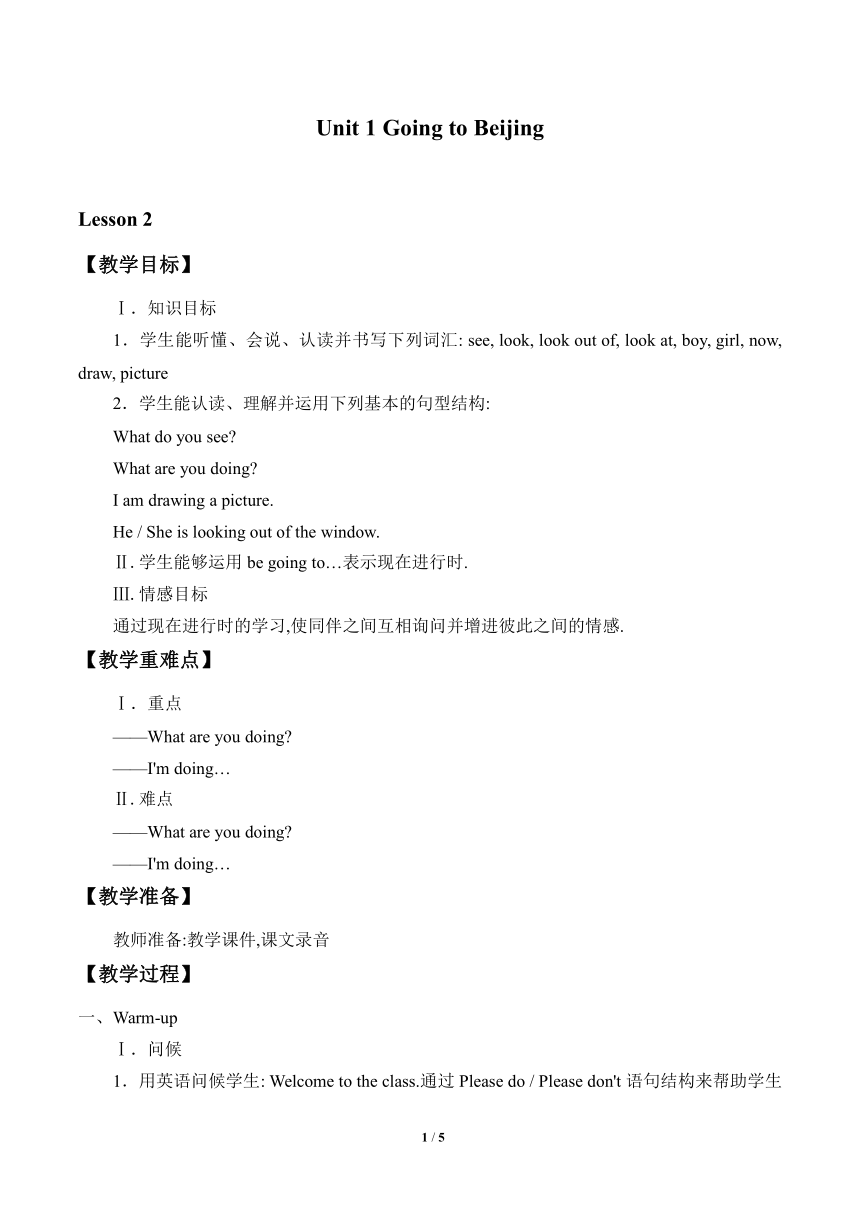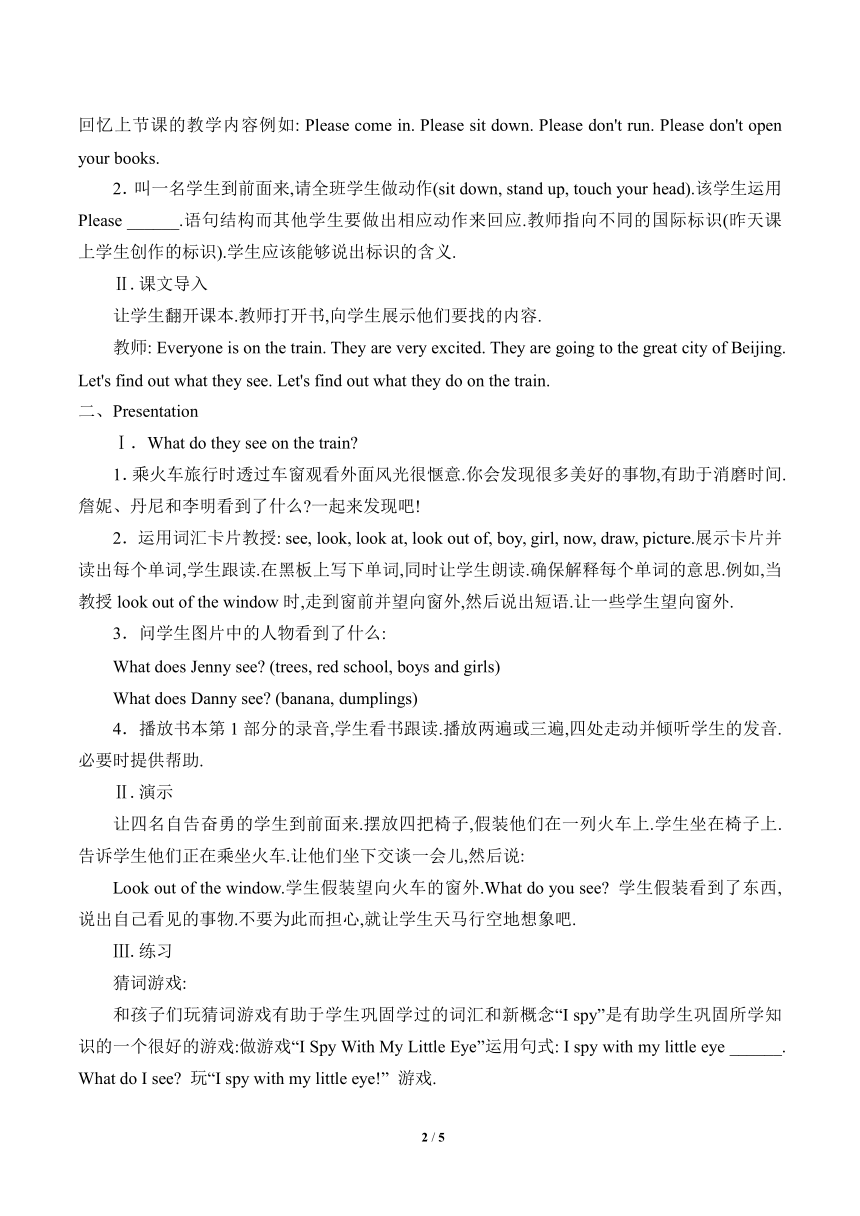Unit 1 Going to Beijing Lesson 2 What Are You Doing? 教案
文档属性
| 名称 | Unit 1 Going to Beijing Lesson 2 What Are You Doing? 教案 |  | |
| 格式 | zip | ||
| 文件大小 | 31.0KB | ||
| 资源类型 | 教案 | ||
| 版本资源 | 冀教版(三年级起点) | ||
| 科目 | 英语 | ||
| 更新时间 | 2021-03-08 17:06:52 | ||
图片预览


文档简介
Unit
1
Going
to
Beijing
Lesson
2
【教学目标】
Ⅰ.知识目标
1.学生能听懂、会说、认读并书写下列词汇:
see,
look,
look
out
of,
look
at,
boy,
girl,
now,
draw,
picture
2.学生能认读、理解并运用下列基本的句型结构:
What
do
you
see?
What
are
you
doing?
I
am
drawing
a
picture.
He
/
She
is
looking
out
of
the
window.
Ⅱ.学生能够运用be
going
to…表示现在进行时.
Ⅲ.情感目标
通过现在进行时的学习,使同伴之间互相询问并增进彼此之间的情感.
【教学重难点】
Ⅰ.重点
——What
are
you
doing?
——I'm
doing…
Ⅱ.难点
——What
are
you
doing?
——I'm
doing…
【教学准备】
教师准备:教学课件,课文录音
【教学过程】
一、Warm-up
Ⅰ.问候
1.用英语问候学生:
Welcome
to
the
class.通过Please
do
/
Please
don't语句结构来帮助学生回忆上节课的教学内容例如:
Please
come
in.
Please
sit
down.
Please
don't
run.
Please
don't
open
your
books.
2.叫一名学生到前面来,请全班学生做动作(sit
down,
stand
up,
touch
your
head).该学生运用Please
______.语句结构而其他学生要做出相应动作来回应.教师指向不同的国际标识(昨天课上学生创作的标识).学生应该能够说出标识的含义.
Ⅱ.课文导入
让学生翻开课本.教师打开书,向学生展示他们要找的内容.
教师:
Everyone
is
on
the
train.
They
are
very
excited.
They
are
going
to
the
great
city
of
Beijing.
Let's
find
out
what
they
see.
Let's
find
out
what
they
do
on
the
train.
二、Presentation
Ⅰ.What
do
they
see
on
the
train?
1.乘火车旅行时透过车窗观看外面风光很惬意.你会发现很多美好的事物,有助于消磨时间.詹妮、丹尼和李明看到了什么?一起来发现吧!
2.运用词汇卡片教授:
see,
look,
look
at,
look
out
of,
boy,
girl,
now,
draw,
picture.展示卡片并读出每个单词,学生跟读.在黑板上写下单词,同时让学生朗读.确保解释每个单词的意思.例如,当教授look
out
of
the
window时,走到窗前并望向窗外,然后说出短语.让一些学生望向窗外.
3.问学生图片中的人物看到了什么:
What
does
Jenny
see?
(trees,
red
school,
boys
and
girls)
What
does
Danny
see?
(banana,
dumplings)
4.播放书本第1部分的录音,学生看书跟读.播放两遍或三遍,四处走动并倾听学生的发音.必要时提供帮助.
Ⅱ.演示
让四名自告奋勇的学生到前面来.摆放四把椅子,假装他们在一列火车上.学生坐在椅子上.告诉学生他们正在乘坐火车.让他们坐下交谈一会儿,然后说:
Look
out
of
the
window.学生假装望向火车的窗外.What
do
you
see?
学生假装看到了东西,说出自己看见的事物.不要为此而担心,就让学生天马行空地想象吧.
Ⅲ.练习
猜词游戏:
和孩子们玩猜词游戏有助于学生巩固学过的词汇和新概念“I
spy”是有助学生巩固所学知识的一个很好的游戏:做游戏“I
Spy
With
My
Little
Eye”运用句式:
I
spy
with
my
little
eye
______.
What
do
I
see?
玩“I
spy
with
my
little
eye!”
游戏.
一个学生心里随便想个什么东西(单词),然后说I
spy
with
my
little
eye
其他的人就轮流说他心里想的是什么东西,谁说对了就赢了。
Ⅳ.What
are
you
doing?
1.播放第2部分的录音,让学生看书跟读.播放两遍.
2.讲授What
are
you
doing?的意思.给学生分配任务:
pretend
that
you
are
drinking
water;
pretend
that
you
are
drawing
a
picture;
pretend
that
you
are
reading
a
book.
每名自告奋勇的学生做一个动作.教师问:
What
are
you
doing?
学生回答:
I
am
______
(教师让学生做的动作).
Ⅴ.演示
现在,让两名自告奋勇的学生到前面来.
教师:
What
is
Jenny
doing?
全班:
She
is
drawing
a
picture.
教师:
What
is
Li
Ming
doing?
全班:
He
is
reading
a
book.
教学提示:当学生进行小组活动时,往往有一两个学生没有参与到活动中.这很常见.如何让这些学生更全身心地参与到活动中呢?当小组活动的时候,教师可以四处走动,随时参与到每一组的讨论中.倾听并且观察,发现哪些学生没有参与到活动中.当小组活动完成后,找机会和那些没有参与活动的学生谈话并问清原因.也许他们不够自信或者没有完全弄懂该做什么.要有耐心并提供帮助.当学生感到自己被关注时,他们会开始努力积极参与小组活动.
Ⅵ.练习
把全班分成小组.给每个小组分配不同的事情去做.一些学生做规定动作,其他学生问:
What
are
you
doing?
读书
打电话
在电脑上工作
洗盘子
跳舞
打扑克
三、Practice
Let's
do
it!
Ⅰ.Read
Part
1and
Part
2.
Tick
or
cross.
让学生翻开书.解释如何完成练习.让学生朗读,本课第部分和第2部分,然后判断每个句子是否正确,并在句子旁边标记对勾或者叉号.
答案:A.√
B.√
C.√
D.×
e.×
Ⅱ.Pair
work.
Point
and
talk.
让学生两人一组完成任务.他们轮流用刚学过的句式提出问题、回答问题.一名学生指向一幅图问:
What
is
______
doing?
另外一名学生阅读词表并找出正确答案,用She
/
He
is
______.句式来回答.
答案:
—What's
Danny
doing?—He's
having
breakfast.
—What's
Jenny
doing?—She's
singing
a
song.
—What's
Danny
doing?—He's
drawing
a
picture.
—What's
Jenny
doing?—She's
reading
a
book.
—What's
Danny
doing?—He's
making
his
bed.
—What's
Jenny
doing?—She's
flying
a
kite.
—What's
Danny
doing?—He's
washing
his
hands.
—What's
Jenny
doing?—She's
looking
out
of
the
window.
四、Consolidation
让学生再次翻到第2部分,向学生提出一些问题.
教师:
What
is
Danny
doing?
学生:
He
is
singing.
教师:
What
does
Mrs.
Li
say
to
Danny?
学生:
Danny,
please
don't
sing!
教师:
Good
job.
Thank
you.
帮助学生找到他们需要做的练习,打开那页并举起来.
五、Summary
重点词汇:
See
,
look,
look
out
of,
look
at,
boy,
girl,
now,
draw
picture
如何用现在进行时询问并回答:
——What…
doing?
——She's/He's/I
am…
【作业布置】
1.观看课文动画并跟读,按照正确的语音、语调朗读并表演课文对话.
2.正确书写本节课所学的单词.(至少5遍,听写1遍)
3.预习Lesson
3.
3
/
5
1
Going
to
Beijing
Lesson
2
【教学目标】
Ⅰ.知识目标
1.学生能听懂、会说、认读并书写下列词汇:
see,
look,
look
out
of,
look
at,
boy,
girl,
now,
draw,
picture
2.学生能认读、理解并运用下列基本的句型结构:
What
do
you
see?
What
are
you
doing?
I
am
drawing
a
picture.
He
/
She
is
looking
out
of
the
window.
Ⅱ.学生能够运用be
going
to…表示现在进行时.
Ⅲ.情感目标
通过现在进行时的学习,使同伴之间互相询问并增进彼此之间的情感.
【教学重难点】
Ⅰ.重点
——What
are
you
doing?
——I'm
doing…
Ⅱ.难点
——What
are
you
doing?
——I'm
doing…
【教学准备】
教师准备:教学课件,课文录音
【教学过程】
一、Warm-up
Ⅰ.问候
1.用英语问候学生:
Welcome
to
the
class.通过Please
do
/
Please
don't语句结构来帮助学生回忆上节课的教学内容例如:
Please
come
in.
Please
sit
down.
Please
don't
run.
Please
don't
open
your
books.
2.叫一名学生到前面来,请全班学生做动作(sit
down,
stand
up,
touch
your
head).该学生运用Please
______.语句结构而其他学生要做出相应动作来回应.教师指向不同的国际标识(昨天课上学生创作的标识).学生应该能够说出标识的含义.
Ⅱ.课文导入
让学生翻开课本.教师打开书,向学生展示他们要找的内容.
教师:
Everyone
is
on
the
train.
They
are
very
excited.
They
are
going
to
the
great
city
of
Beijing.
Let's
find
out
what
they
see.
Let's
find
out
what
they
do
on
the
train.
二、Presentation
Ⅰ.What
do
they
see
on
the
train?
1.乘火车旅行时透过车窗观看外面风光很惬意.你会发现很多美好的事物,有助于消磨时间.詹妮、丹尼和李明看到了什么?一起来发现吧!
2.运用词汇卡片教授:
see,
look,
look
at,
look
out
of,
boy,
girl,
now,
draw,
picture.展示卡片并读出每个单词,学生跟读.在黑板上写下单词,同时让学生朗读.确保解释每个单词的意思.例如,当教授look
out
of
the
window时,走到窗前并望向窗外,然后说出短语.让一些学生望向窗外.
3.问学生图片中的人物看到了什么:
What
does
Jenny
see?
(trees,
red
school,
boys
and
girls)
What
does
Danny
see?
(banana,
dumplings)
4.播放书本第1部分的录音,学生看书跟读.播放两遍或三遍,四处走动并倾听学生的发音.必要时提供帮助.
Ⅱ.演示
让四名自告奋勇的学生到前面来.摆放四把椅子,假装他们在一列火车上.学生坐在椅子上.告诉学生他们正在乘坐火车.让他们坐下交谈一会儿,然后说:
Look
out
of
the
window.学生假装望向火车的窗外.What
do
you
see?
学生假装看到了东西,说出自己看见的事物.不要为此而担心,就让学生天马行空地想象吧.
Ⅲ.练习
猜词游戏:
和孩子们玩猜词游戏有助于学生巩固学过的词汇和新概念“I
spy”是有助学生巩固所学知识的一个很好的游戏:做游戏“I
Spy
With
My
Little
Eye”运用句式:
I
spy
with
my
little
eye
______.
What
do
I
see?
玩“I
spy
with
my
little
eye!”
游戏.
一个学生心里随便想个什么东西(单词),然后说I
spy
with
my
little
eye
其他的人就轮流说他心里想的是什么东西,谁说对了就赢了。
Ⅳ.What
are
you
doing?
1.播放第2部分的录音,让学生看书跟读.播放两遍.
2.讲授What
are
you
doing?的意思.给学生分配任务:
pretend
that
you
are
drinking
water;
pretend
that
you
are
drawing
a
picture;
pretend
that
you
are
reading
a
book.
每名自告奋勇的学生做一个动作.教师问:
What
are
you
doing?
学生回答:
I
am
______
(教师让学生做的动作).
Ⅴ.演示
现在,让两名自告奋勇的学生到前面来.
教师:
What
is
Jenny
doing?
全班:
She
is
drawing
a
picture.
教师:
What
is
Li
Ming
doing?
全班:
He
is
reading
a
book.
教学提示:当学生进行小组活动时,往往有一两个学生没有参与到活动中.这很常见.如何让这些学生更全身心地参与到活动中呢?当小组活动的时候,教师可以四处走动,随时参与到每一组的讨论中.倾听并且观察,发现哪些学生没有参与到活动中.当小组活动完成后,找机会和那些没有参与活动的学生谈话并问清原因.也许他们不够自信或者没有完全弄懂该做什么.要有耐心并提供帮助.当学生感到自己被关注时,他们会开始努力积极参与小组活动.
Ⅵ.练习
把全班分成小组.给每个小组分配不同的事情去做.一些学生做规定动作,其他学生问:
What
are
you
doing?
读书
打电话
在电脑上工作
洗盘子
跳舞
打扑克
三、Practice
Let's
do
it!
Ⅰ.Read
Part
1and
Part
2.
Tick
or
cross.
让学生翻开书.解释如何完成练习.让学生朗读,本课第部分和第2部分,然后判断每个句子是否正确,并在句子旁边标记对勾或者叉号.
答案:A.√
B.√
C.√
D.×
e.×
Ⅱ.Pair
work.
Point
and
talk.
让学生两人一组完成任务.他们轮流用刚学过的句式提出问题、回答问题.一名学生指向一幅图问:
What
is
______
doing?
另外一名学生阅读词表并找出正确答案,用She
/
He
is
______.句式来回答.
答案:
—What's
Danny
doing?—He's
having
breakfast.
—What's
Jenny
doing?—She's
singing
a
song.
—What's
Danny
doing?—He's
drawing
a
picture.
—What's
Jenny
doing?—She's
reading
a
book.
—What's
Danny
doing?—He's
making
his
bed.
—What's
Jenny
doing?—She's
flying
a
kite.
—What's
Danny
doing?—He's
washing
his
hands.
—What's
Jenny
doing?—She's
looking
out
of
the
window.
四、Consolidation
让学生再次翻到第2部分,向学生提出一些问题.
教师:
What
is
Danny
doing?
学生:
He
is
singing.
教师:
What
does
Mrs.
Li
say
to
Danny?
学生:
Danny,
please
don't
sing!
教师:
Good
job.
Thank
you.
帮助学生找到他们需要做的练习,打开那页并举起来.
五、Summary
重点词汇:
See
,
look,
look
out
of,
look
at,
boy,
girl,
now,
draw
picture
如何用现在进行时询问并回答:
——What…
doing?
——She's/He's/I
am…
【作业布置】
1.观看课文动画并跟读,按照正确的语音、语调朗读并表演课文对话.
2.正确书写本节课所学的单词.(至少5遍,听写1遍)
3.预习Lesson
3.
3
/
5
同课章节目录
- Unit 1 Going to Beijing
- Lesson 1 I Am Excited!
- Lesson 2 What Are You Doing?
- Lesson 3 Who Is Singing?
- Lesson 4 Who Is Hungry?
- Lesson 5 What Are They Doing?
- Lesson 6 Danny Is Lost!
- Again, Please!
- Unit 2 In Beijing
- Lesson 7 Arriving in Beijing
- Lesson 8 Tian'anmem Square
- Lesson 9 The Palace Museum
- Lesson 10 The Great Wall
- Lesson 11 Shopping in Beijing
- Lesson 12 A Visit to the Great Wall
- Again, Please!
- Unit 3 Writing Home
- Lesson 13 Let's Buy Postcards!
- Lesson 14 Jenny Writes a Postcard
- Lesson 15 Sending the Postcards
- Lesson 16 An Email Is Fast
- Lesson 17 Danny's Email
- Lesson 18 Little Zeke Sends an Email
- Unit 4 Did You Have a Nice Trip?
- Lesson 19 Li Ming Goes Home
- Lesson 20 Jenny Goes Home
- Lesson 21 Look at the Photos!
- Lesson 22 Gifts for Everyone
- Lesson 23 An Email from Li Ming
- Lesson 24 A Gift for Little Zeke
